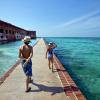Your Guide to Saltwater Fishing in Florida
Love saltwater fishing? Whether you prefer to fish from a boat or a pier, for gamefish or dinner, Florida saltwater fishing has what you're looking for.
When it comes to designing the ultimate saltwater fishing destination, Florida serves as the ultimate blueprint. Why so? Because its geography offers access to the Gulf Stream, reefs, wrecks, estuaries, bays, inlets and rivers. Added together they afford the chance to fish for everything from bonefish to billfish - all in the same day if desired.
Here's a rundown of these popular angling haunts for Florida saltwater fishing and successful techniques for what you might encounter.
Gulf Stream
It's deep, it's blue, and it's full of large game fish that can turn the shape of a rod into a pretzel. Here lurk awesome battlers such as blue marlin, wahoo, sailfish, dolphin, kingfish, swordfish, yellowfin and blackfin tuna, and sharks longer than the width of some boats. Trolling lures and baits is the best bet, although offshore fly fishing has increased in popularity.
Flats
It's amazing how a fat snook or redfish can traverse shallow waters about the length of your hand, but best results occur in water two feet or less in depth, particularly with sea grasses and bottom contours and sediments conducive to homesteading by crabs, shrimps and other fish munchies. Wading is popular (taking care to slide your feet to ward off stingrays), as is casting from shorelines. The ultimate challenge is sight-fishing from a boat being silently poled by a guide. Unsurpassed flats fishing is the hallmark of the Florida Keys.
Bays
Being relatively shallow and easier on the kidneys than fishing offshore, bay waters teem with a hodgepodge of game fish favorites. Take a variety of rods and reels - light, medium and heavy - to aptly duel with whatever slurps up your bait or make-believe morsel. Some of the fishier hot spots are Biscayne Bay, Florida Bay, Whitewater Bay, Chokoloskee Bay, Ponce de Leon Bay, Charlotte Harbor, Tampa Bay, Homosassa Bay, Waccasassa Bay, Apalachee Bay, West Bay Panama City and East Bay Panama City, and Pensacola Bay.
Jetties
Look for concrete or rocky jetties that line both sides of a choice spot such as Sebastian Inlet. Many inlets are angler-friendly, providing access and facilities. Jockey to find a good casting stage for shots at tarpon, snook, redfish, jacks and mackerel that congregate during tidal changes. Free-line a floating live crab or shrimp with the current or cast a lead-head jig or lure up-current and work it back to you.
Bridges
Night fishing is best, especially on a full-moon phase. Cast a jig tipped with a shrimp up-current and hop it back to the piling. You'll lose a few rigs in the rocks but you'll also catch more snook and tarpon than anyone else. Many of the Keys bridges are perfect for this, as well as the Sunshine Skyway off Tampa. Some bridges offer catwalks and other facilities. Some bridges do not allow fishing, so follow posted regulations.
Piers
No boat? No problem. Just walk to deeper water. Pier anglers regularly catch Spanish mackerel, snook, tarpon, sheepshead, redfish, trout and other stars of the fishing world. Pilings themselves serve as an attractant, and lights shown in the water at night become fish magnets. Excellent pier fishing can be found in Broward and Miami-Dade counties as well as in the Panhandle.
Shoreline
Islands, beaches and even rocky coastal areas can be fished with good results. Move along quietly as fish can hear the slightest noises or even see you. Either soak a bait on the bottom or cast parallel to the beach to tempt snook or reds hunting the troughs for chewables.
Rivers
Mangrove shorelines and overhanging trees provide fish with a respite from direct sunlight. Drift along promising banks and cast the edges of the shoreline and near dead tree limbs, stumps and other obstructions. Anchor at a promising spot and cast up-current to work your offering past target points.
Any of these places and techniques for tangling with game fish will produce successful Florida saltwater fishing trips. Be a part of the fun, but remember to keep only the fish you'll eat that night and release the rest. That will help ensure a healthy fishery in the future for both you and your children.
























